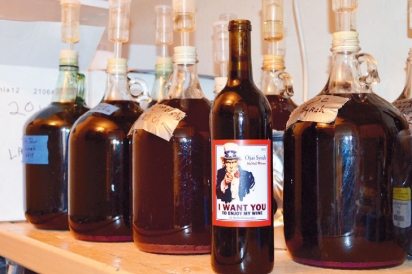John McNeil: Dr Grape
For many Ojai residents, John McNeil is the dentist who reminded them to brush and floss over the course of his 40-year dental practice. But for the people who grow grapes and want to turn the fruit into wine, McNeil is known as Dr. Grape.
McNeil has been growing grapes and making wine in the Ojai Valley for 35 years. In that time, he has guided many through the winemaking process. “There are a lot of people growing grapes in the Valley. I work with about 10 families right now,” he says. “I step in for a year or two, teach them, and then step out. In exchange, I get some of the fruit, or an option to buy some, for my own wine.”
His roots in winemaking can be traced to a California tradition that goes back almost 130 years. A native of Pasadena who attended St. Mary’s College in Northern California, McNeil became interested in winemaking as an undergrad.
The college is run by the Christian Brothers, who have been growing grapes and making wine in the Napa area since 1882. “One day Brother Timothy came and gave a talk about winemaking. I told him I wanted to learn that,” McNeil recalls. “He knew I was pre-med and he told me ‘Anybody can make wine but not everybody can be a doctor.’”
McNeil took Brother Timothy’s advice and became a dentist, practicing in Ojai from the time he moved to town with his wife, Joan, in the mid-1960s. But he never gave up his dream of being a winemaker. When he was still in college, he started out with grapes he bought from a family in San Francisco’s North Beach neighborhood. “They grew grapes downtown back then,” says the retired dentist, who volunteers at Salvation Army Dental Services in Oxnard.
His first effort—he thinks it was probably a Zinfandel—was not a success. “I bought between 100 and 200 pounds of fruit and read a [winemaking] book,” McNeil says. “The wine tasted awful and my friends agreed. They didn’t even have to say anything—I could tell by their faces. I dumped it.”
Current production of his Uncle Sam-inspired I Want You To Enjoy My Wine label of about 125 cases is mostly Syrah, sourced primarily from Topa Topa Vineyards in Ojai the last four to five years.
When he makes the Syrah, he follows a common practice in France’s Rhone Valley that results in a very sophisticated and complex wine: He incorporates Viognier into it.
His new endeavor is making a Grenache-Syrah blend with grapes from another Ojai vineyard. He’s doing some Chardonnay, too.
Over the years, he’s used cuttings from Roll Ranch that he got from Adam Tolmach of The Ojai Vineyard to root and plant at other vineyards he’s working with in the area. He and Tolmach have maintained a friendship over the years, and McNeil credits Tolmach as a big influence. “He is my inspiration,” McNeil says.
McNeil’s son, John Kennedy McNeil, planted 10 Viognier cuttings and 115 Syrah vines at his home a few years ago. (Both varietals do nicely in Ojai’s warm climate and moderately sandy soil.) He made his first wine in 2015 from the vineyard, under his father’s tutelage.
The elder McNeil’s wines have been successful in competition. His 90% Syrah, 10% Viognier blend won Best In Show at the 2015 Ventura County Fair, and he took home a bronze medal for his 100% Syrah at the 2014 Winemaker International Amateur Wine Competition in Burlington, Vermont, among other awards over the years.
Despite the accolades, he has no plans to go commercial. “It’s a hobby,” he says. “I give away 90% of what I make.”
One thing McNeil is not is a wine snob. The first wine he fell in love with was Lancer’s Rosé, a sweet, fizzy pink wine in a faux terra- cotta bottle popular in the 1960s and ‘70s. His current tastes run to intensely juicy Zinfandels with a big alcohol content—known as “hot” among wine connoisseurs and often spoken of disparagingly. “I like oaked Chardonnays, too,” he says, referring to another California style of wine that has fallen out of favor among some wine drinkers.
While McNeil says he likes to follow the winemaking process “from growing to drinking,” he especially enjoys the harvest. “It’s a fun time,” he says, despite the hot, dusty, heavy labor that makes for thirsty workers. “Harvest,” he says, “is when you learn it takes a lot of beer to make good wine.”






